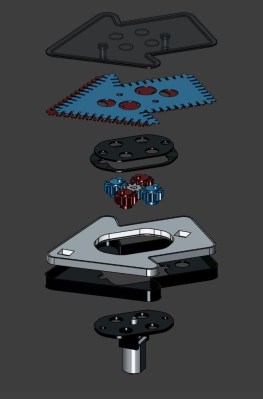Around these parts, projects needlessly using a microcontroller where a simpler design would do are often derided with the catch-all “Should have used a 555,” even if the venerable timer chip wouldn’t have been the ideal solution. But the sentiment stands that a solution more complicated than it needs to be is probably one that needs rethinking, as this completely mechanical chaser light badge Simple Add-On (SAO) aptly demonstrates.
 Rather than choosing any number of circuits to turn a strip of discrete lights on and off, [Johannes] took inspiration for his chaser lights from factory automation mechanisms that move parts between levels on steps that move out of phase with each other, similar to the marble-raising mechanism used in [Wintergatan]’s Marble Machine X.
Rather than choosing any number of circuits to turn a strip of discrete lights on and off, [Johannes] took inspiration for his chaser lights from factory automation mechanisms that move parts between levels on steps that move out of phase with each other, similar to the marble-raising mechanism used in [Wintergatan]’s Marble Machine X.
Two thin plates with notches around the edge are sandwiched together inside the 3D printed case of the SAO, between the face and the light source. A small motor and a series of gears rotate the two masks 180° out of phase with each other, which creates the illusion that the light is moving.
It’s pretty convincing; when we first saw the video below, we were sure it was a row of tiny LEDs around the edge of the badge.
Hats off to [Johannes] for coming up with such a clever mechanism and getting it working just in time for Hackaday Europe. If you need to catch up on the talks, we’ve got a playlist ready for you.
















Berlin sign should point left.
What am I missing?
Why’s that?
Your left or mine?
They’re already as far left as they can get.
“Everything points to Berlin Mitte” is the German “All roads lead to Rome”.
That would be a cool technique to make a projected chaser that could be aimed at existing signage, or used as a stage lighting effect.
I saw this at the event and it was an amazing thing. I asked the maker ‘how did you do the LEDs’ and he then calmly explained it was mechanical. I LOVE IT.
Thanks! I really enjoyed the in person interactions with this one. Once people got close enough to hear the motor it was always great to see the reactions of being cought off guard by it being mechanical :)
Love it!
When a grid’s misaligned
with another behind,
that’s a moiré…
(credit to xkcd)
When a river’s across
the bottom right part of Oz
that’s a Murray
Why am I thinking a small micro would have been simpler?